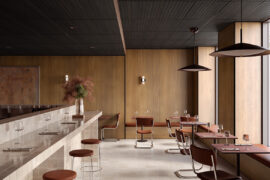In a decade or two, most of our waking hours might be spent inside a pair of VR glasses. Will we be comfortable in VR, or, for that matter, with it?
January 9th, 2018
At the time of writing, Facebook Spaces – Facebook’s VR app – had just been made available in beta stage. Mark Zuckerberg’s live demo presented at the Oculus Connect summit last year was an impressive showcase of the app’s early-phase VR capabilities. In that demo, he and two Facebook employees convened and interacted –played, really – conjuring objects such as a chess set and playing cards, even fashioning their own pencil drawings into weapons for a sword fight.
They also ‘teleported’ to various 360-degree video environments together: from underwater to Mars – all fun and quite out of this world, but not as remarkable, perhaps, as when they went to Zuckerberg’s home. Zuckerberg had promised Priscilla, his wife, to check on Beast, their real-life dog. Beast was found on the sofa and appeared to be fine. Zuckerberg then answered a Messenger video call from Priscilla (who was not in VR), took a selfie with a selfie stick, and posted the photo to his real-life Facebook feed – all from within his VR space.
What Zuckerberg demonstrated is that VR is no longer that imaginative other world to which we escape individually; VR is now proposed as a habitable, connected, and viably useful, if alternative environment. Virtual and real might be thought as parallel worlds between which convergences and ‘passages’ are actually already happening.
The question is, will we be comfortable in VR, or, with it? People who have experienced VR environments attest to its ‘realness’. They can ‘feel the space’ or ‘feel present’ in that space. Dr Frank Steinicke, a professor at the University of Hamburg’s Human-Computer Interaction team at the Department of Informatics, spent 24 hours in the Oculus VR to study its effects. Apart from dry eyes, he reported that he had experienced “strong moments of presence” such as feeling colder when his virtual sun went down. “We should be concerned about what VR is doing to us and what it could be doing to the brain,” Steinicke said in an interview, “and if we wear for longterm, will we lose the ability to communicate in the real world?”
Surely, VR’s capabilities – and its Pandora’s box of implications – are real and we ought to move forward with care. If virtual worlds are compelling enough (and its potential of offering alternative environments may be an attractive choice, say, for the growing class of people living in tiny, uniform, shoebox apartments), we will likely be quick to adapt and integrate the technology, as we have with our smartphones. The State Government of Victoria in Australia has, for instance, installed traffic lights on the ground in Melbourne’s CBD for pedestrians who are constantly looking downward at their phones. In Singapore, Olivia Lee has proposed a set of home furniture and products designed to work with the way we use today’s handheld devices and social media. The Athena Collection, which she presented at the SaloneSatellite in April, included a carpet with tactile details and borders to demarcate virtual and physical space during gaming or VR use.
Not only are our real-life spaces being reshaped to suit our digital lifestyle, entire sociological and cultural shifts are happening. At House Vision 2, an exhibition curated by Kenya Hara to explore the future of urban living, One Family Under a Wireless Roof put forward the idea that it is a wireless network, rather than a physical roof of the home, that keeps a family close today. The proposal, which incorporated Culture Convenience Club’s TONE smartphone service, was for a shared network that would enable physically separated family members to stay in touch. It offers functions such as the ability to knock on a family member’s virtual door through a tap on the phone. Essentially a virtual family house (an idea with great potential in the realm of VR), the project demonstrated how our notions of home and familial connections have shifted. Visitors to the exhibition (designed by HARA Design Institute) could watch a VR short story (by Shinya Nakajima) about the concept.
For better or for worse, VR, as with all technology, will continue its march of progress and we as a species will adapt (sociologically, even anthropologically). Perhaps the crux of the matter is not our capabilities as such, but whether this whole movement is one that provides real comfort and answers real needs – and whose, for that matter. But that is another discussion.
Keen to see more? Take a look at 1-OK Club’s virtual exhibition.
INDESIGN is on instagram
Follow @indesignlive
A searchable and comprehensive guide for specifying leading products and their suppliers
Keep up to date with the latest and greatest from our industry BFF's!

Welcomed to the Australian design scene in 2024, Kokuyo is set to redefine collaboration, bringing its unique blend of colour and function to individuals and corporations, designed to be used Any Way!

A curated exhibition in Frederiksstaden captures the spirit of Australian design

Featuring prominent Sydney designers and hosted by Royal Oak Floors, this panel event will ask: What does it take to build a practice that’s distinctive and unmistakably yours?

Davenport Campbell’s Neill Johanson shares insights from WORKTECH25 and the impact of AI on the workplace experience.
The internet never sleeps! Here's the stuff you might have missed

On 6th September, Saturday Indesign lit up Melbourne with a day of immersive installations, design talks and showroom activations across three thrilling precincts.

Australian designed and manufactured, Laminex Architectural Panels transform timber design aesthetics with cutting-edge technology